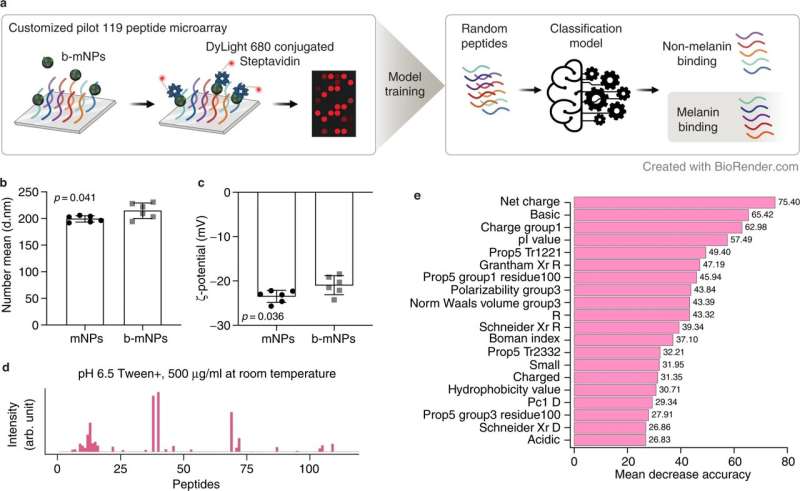This article has been reviewed according to Science X's editorial process and policies. Editors have highlighted the following attributes while ensuring the content's credibility:
fact-checked
peer-reviewed publication
trusted source
proofread
AI used to advance drug delivery system for glaucoma and other chronic diseases

Johns Hopkins Medicine researchers say they have used artificial intelligence models and machine-learning algorithms to successfully predict which components of amino acids that make up therapeutic proteins are most likely to safely deliver therapeutic drugs to animal eye cells.
The project, a collaboration with researchers from the University of Maryland, holds promise for advancing new and more tolerable drug treatments for common chronic blinding eye diseases, including glaucoma and macular degeneration, which affect 3 million and about 20 million people in the United States, respectively.
Current drug therapies for these diseases, consisting of multiple daily eyedrops or frequent eye injections, are effective, but such delivery systems may be difficult to sustain and tolerate over time, and have encouraged scientific efforts to develop delivery systems that would bind to components of eye cells and safely extend the therapeutic impact of the medications they carry.
In 2020, the Food and Drug Administration approved an implantable device that can be placed in the eye and release drugs to treat glaucoma. While that device worked for longer periods than drops or injections, prolonged use was shown in some cases to cause eye cell death, requiring patients to revert to eye drops and injections.
Published in Nature Communications, the new research showed that artificial intelligence-designed models accurately predicted an effective sequence of amino acids, also known as peptides or small proteins, that would bind to a particular chemical in rabbit eye cells and safely dispense medications over several weeks, reducing the need for frequent, strict treatment schedules.
The team specifically investigated peptides that bind to melanin, a compound that provides color to the eye but has the advantage of being widely present throughout specialized structures in eye cells.
The research team noted that other studies investigating drug delivery using peptides have shown how effective this system can be, but they wanted to find peptides that would strongly bind with a widespread eye compound. To do that, the team reasoned that rapid machine learning using artificial intelligence methods could help sort out and predict an effective peptide sequence to try, according to Laura Ensign, Ph.D., the Marcella E. Woll professor of ophthalmology at the Johns Hopkins University School of Medicine, and co-corresponding author of the paper.
The team started by feeding a machine learning model thousands of data points, including characteristics of amino acids and peptide sequences. These data helped the computer model "learn" the chemical and binding properties of certain amino acid combinations, and in time, how to predict candidate peptide sequences for drug delivery using melanin.
The artificial intelligence model generated 127 peptides that were predicted to have varying ability to penetrate the specialized cells that house melanin, to bind to melanin and to be nontoxic to the cells. Out of these 127 peptides, the model predicted that a peptide called HR97 had the highest success rate of binding. The team also confirmed the properties of these peptides, including better uptake and binding within cells as well as no indication of cell death.
To test the model's prediction, researchers attached HR97 to the drug brimonidine, which is used to treat glaucoma by lowering inner eye pressure, and injected it into adult rabbit eyes. To determine HR97's performance, researchers measured the levels of brimonidine in the eye cells by testing the cells' concentrations of the drug after administering the experimental drug delivery system.
They found that high amounts of brimonidine were present for up to one month, indicating that HR97 successfully penetrated cells, bound to melanin, and released the drug over a longer period of time. Researchers also confirmed that the eye pressure-lowering effect of brimonidine lasted for up to 18 days when bound to HR97, and found no indication of irritation in the rabbits' eyes.
Ensign says that future studies using artificial intelligence to predict peptides for drug delivery have huge ramifications for other conditions that involve melanin, and can be extended to targeting other specialized structures.
"We believe we are well on the way to finding solutions in trying to improve patient care and quality of life using drug delivery systems. The ultimate goal is creating something that we can translate out of the lab and actually make people's lives better," says Ensign.
Moving forward, Ensign says, researchers will need to find ways to further extend the duration of action, to test the success rate of the AI model's drug delivery predictions with other drugs, and to determine safety in humans.
More information: Henry T. Hsueh et al, Machine learning-driven multifunctional peptide engineering for sustained ocular drug delivery, Nature Communications (2023). DOI: 10.1038/s41467-023-38056-w




















